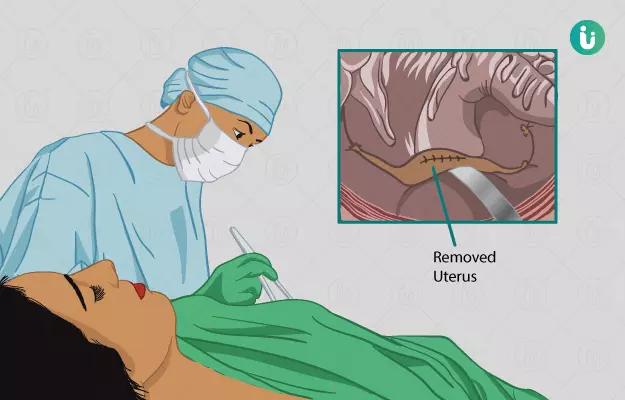Summary
Hysterectomy is a surgical procedure, which is performed mainly to remove the womb but it can be used to remove other reproductive organs as well depending on your condition and the doctor’s advice. There can be several reasons for the removal of the womb, such as cancer, infection, fibroids, endometriosis and so on. The removal of only a part of the womb is called subtotal hysterectomy and when the womb is removed along with all the other reproductive parts, it is called a radical hysterectomy. The surgery can be performed by three approaches, vaginal, abdominal (through the belly) and laparoscopic hysterectomies. Vaginal hysterectomy is preferred over abdominal hysterectomy. Laparoscopy is used these days, which involves an instrument having a thin tube with a camera at the end to see the organs inside the body, such as a womb, on a screen, which gives a clear vision to the surgeon. This is known as laparoscopic hysterectomy. There are a few risks and complications which may occur during and after the surgery, such as an injury to the blood vessels and not being able to get pregnant again. The surgical wound can take around 6-8 weeks to heal and has a high success rate.
- What is hysterectomy
- Why is hysterectomy done
- Preparations before surygery
- How is hysterectomy done
- Things to take care of after hysterectomy
- What precautions should be taken after hysterectomy
- Risks and complications of hysterectomy
- Follow-up after hysterectomy
What is hysterectomy
The female reproductive system includes different organs like the womb/uterus, ovaries (paired organs one on each side of the uterus, which produce eggs and female hormones), fallopian tubes (thin tubes present on both sides of the womb connecting the womb to the ovary on each side and allow passage of the egg from ovary to the womb), cervix (birth canal) and vagina (a tube made up of muscles connecting the cervix to the outside).
Hysterectomy is the procedure which is performed by a surgeon, mainly a gynaecologist (a doctor who is a specialist in the treatment of female reproductive diseases) to remove the womb with or without the other related organs, such as the cervix, fallopian tubes, vagina and ovaries. Either the whole womb is removed (total hysterectomy) or some part of it is left inside, which is known as subtotal hysterectomy. The surgery depends on the condition for which you are being treated. After the hysterectomy, a woman won’t be able to give birth to a baby again and will not have her monthly periods.
Why is hysterectomy done
The womb is considered one of the main reproductive organs in a woman's body. There are so many reasons to why it can get damaged. There are different methods of treatment by which the damaged uterus can be repaired but sometimes these methods don't work. The surgical removal of the womb is then considered to be the last option when no other treatment option is working. The following are a few reasons why hysterectomy is needed:
Fibroids
It is the increased growth of the muscles inside the walls of the womb. The growth may extend outside or inside leading to a change in the shape of the womb. A fibroid can be as small as the size of a pea or can be larger in size. These are not something that is known to cause cancer. There are medicines for its treatment but sometimes when the growth is large, it needs to be removed surgically. It can lead to heavy period bleeding, stomach pain, difficulty during pregnancy and may even lead to never being able to give birth again.
Prolapse of the womb
The womb stays in its position in a woman's body due to the strong muscles and ligaments that attach it to the abdominal wall. Sometimes, due to various reasons, such as getting pregnant a number of times without giving space between each pregnancy, getting abortions frequently and problems with periods can have a negative impact on the muscles and ligaments of the womb. This can lead to a change in position of the womb and cause it to fall into the vagina. There are different surgical procedures to get the womb back to its original position but if these fail then it has to be removed.
Cancer of the womb/uterus
The cancer of the womb can either start in the uterus or may be transferred from any other cancerous organs in the woman's body, such as the fallopian tubes, cervix, and vagina. This is a severe condition. If cancer fails to heal by medication and other techniques then surgical removal of the womb is done.
Endometriosis
The cells which are found in the lining of the womb are not found anywhere else in the body. In endometriosis, this cell lining grows outside the womb and starts collecting on its adjacent organs, such as the fallopian tubes, ovaries and inner lining of the abdomen. These cells grow, and under the influence of female sex hormones, they break off and bleed from the adjacent organs just like how it bleeds after the lining break in the womb. After the medical as well as surgical treatment for endometriosis, there can be heavy blood loss during periods, pain as well as twitch in the womb. The last option left in such cases is the surgical removal of the womb.
Adenomyosis
In this condition, there is increased growth of the cells lining the womb, which makes the lining thicker leading to increased blood loss during periods, swelling in the stomach, and pain and twitching in the uterus. If it can't be cured with other medical treatments then surgical removal of the womb is considered.
The surgery should be done only in those women who are not going to give birth or don't want to give birth because, after the surgery, a woman cannot get pregnant.
Preparations before surygery
Tests to be done before surgery
Before surgery is done, there are many tests which your doctor may suggest, such as an X-Ray, Electrocardiogram (ECG), Magnetic Resonance Imaging (MRI), Complete Blood Count (CBC), urine test, ultrasound of the womb and tests related to the specific organ for which you are going to get operated.
Testing of the numbing agent before surgery
The selection of the numbing agent depends upon the type of surgery. Numbing agents are given before surgery so you don’t feel pain while getting operated. You may be advised not to eat anything at least 6 - 12 hours before surgery because due to the numbing agent, you may vomit during surgery that can also result in the flow of food into the windpipe.
Planning the surgery
It is important for your doctor to plan the surgery. He/She would tell you about the risks and benefits which will be there after the surgery. You should tell your doctor about any medical history like liver disease, heart disease or mental disorders, any previous medications you have been taking, such as aspirin, which is a blood thinner, any addiction to alcohol, tobacco and other drugs. This would prevent any complications during and after the surgery
- Medications needed before the surgery
The medications prescribed by your doctor may include antacids, which are necessary as the surgery can lead to excessive production of acid in the stomach, painkillers for the pain after the surgery and antibiotics to prevent any infections. It is important for you to understand and take proper medication before the surgery to avoid complications. - On the day of the surgery
You will be asked to give consent before the surgeon takes you to the operation theatre that you have given your permission to your doctor to perform this surgery. Your blood pressure, temperature, blood tests, and airway will be checked again before preparing you for the surgery. You will be asked to wear a germ-free surgical gown. During surgery, you will be covered with a germ-free cloth and only the area where the surgery is to be performed will be exposed. After preparing you for the surgery, the numbing agent (anaesthesia) will be administered. - General information
You should not smoke or drink alcohol before surgery as it will decrease the rate of recovery. You should not stress out and should stay calm physically as well as mentally. Someone from the family or close friends should accompany you to the hospital.
How is hysterectomy done
Hysterectomy can be performed either through the stomach, which is known as abdominal hysterectomy or through the vagina, which is known as a vaginal hysterectomy. The whole womb or a part of it can be removed depending upon the severity and type of condition. The cost of hysterectomy ranges from 18000 INR to 2,30,000 INR. It depends upon the healthcare facility and also on the technique used; the cost of laparoscopic hysterectomy is higher than that of abdominal hysterectomy. The techniques used for hysterectomy are:
Abdominal (stomach) hysterectomy
It is mostly chosen when the womb is large in size. The cut made during this surgery is large enough to take out the womb safely. It is also known as open surgery as the stomach is made wide open to take out the womb. The procedure is as follows:
- A five inches long cut is made in the lower part of the stomach, which can be a straight or a crosscut.
- The muscles, blood vessels and fascia, (a thin tissue layer covering the muscles and organs) are carefully separated.
- The ligaments that keep the womb in its position are cut. The healthy muscles, blood vessels and other organs are safely handled during the procedure.
- Finally, the womb is taken out of the body.
- After removing the womb, the muscles and other organs are stitched back to their original positions.
Vaginal hysterectomy
It is an easier and commonly used surgical procedure to remove the womb as well as the cervix and the fallopian tubes. Ovaries can be removed but with difficulty. The procedure includes the following steps:
- It is not an open surgical procedure, which means it does not involve any cut on the skin.
- The surgical instruments are used through the vagina, the circumference of the vaginal opening can be increased with the help of surgery if required.
- After removing the womb, the cut made to increase the circumference of the vaginal opening is stitched.
Laparoscopic hysterectomy
In this surgery, the chance of damaging the other organs is minimum. It is not an open surgery. It can be used in both kinds of surgical approaches, abdominal as well as vaginal, to remove the womb. The steps are of performing this surgery are:
- In a laparoscopic abdominal hysterectomy, small cuts, which are about two to four in number and about 3 cm long, are made on the lower part of the stomach.
- From one of the cuts, a thin tube with a camera at the end is inserted inside. This helps in clearly viewing the internal organs on screen in 3D so that the surgeon is careful while performing the procedure.
- In the laparoscopic vaginal hysterectomy, the tube is inserted with the camera at its one end through the vagina to see the internal organs.
- These days, robotic laparoscopy is also available, which can be performed by using robotic arms.
Things to take care of after hysterectomy
After the surgery, it takes at least 6 to 8 weeks to resume normal physical activity and to heal properly. Till then you should take care of yourself and of your wound in the following ways:
- The amount of work you do should be increased slowly and gradually, start with doing slow walks and doing light household work.
- The prescribed ointment should be applied and the dressing should be changed twice a day or as per suggested by your doctor.
- If you see that there is swelling or bleeding from the wound, immediately report to your doctor.
- You should take the medicines regularly and as prescribed by your doctor following the correct dosage and try to maintain the same time each day while taking them, especially the painkillers because it increases their effect.
- You can press a pillow on your dressing lightly if you want to cough or sneeze, it will protect your incision from opening and help ease your pain.
- Use ice packs for the first few days after surgery. It helps in relieving the swelling and pain.
- You should eat a lot of fruits and drink a lot of water to keep yourself hydrated and to avoid constipation.
What precautions should be taken after hysterectomy
There are a few things that you should be cautious about after surgery. These are discussed below:
- You should avoid all kinds of heavy activities including going to the gym, jogging, climbing stairs, washing clothes and utensils at least for the first 4-6 weeks after surgery.
- Avoid driving for 2-3 weeks. Travelling in a car will be alright. Avoid going on long trips.
- Don't indulge in sexual activity until 6-8 weeks after surgery.
- Avoid activities like swimming or bathing in a bathtub so that the wound is not in direct contact with water. You can take a sponge bath. The wound should be kept clean and dry.
Risks and complications of hysterectomy
- During the recovery period, you may have fever due to infection in the wound or urinary bladder, an organ which stores urine in the body. Your doctor will prescribe you antibiotics for controlling the problem.
- You make require extra blood of the same blood group as yours before surgery if you have anaemia or there occurs an injury to any blood vessels during surgery, which may lead to increased blood loss.
- There can be complications while or after giving the numbing agent to you. if you consume tobacco, alcohol or any other drugs, are obese or have any medical conditions of the heart and liver.
- You may frequently feel the urge to pass urine or lose control over urination if there is an injury to the urinary bladder. If an injury occurs to the anal canal then you may lose control while taking a dump.
- If during the surgery, your ovaries are removed along with the womb then you may have symptoms of depression, less interest in sexual activity, skin problems and decreased metabolism.
- It is not possible to conceive and give birth to a child after this surgery.
Follow-up after hysterectomy
Follow up visits are scheduled after surgery by your doctor to see your progress after surgery. Depending upon the type of surgery, certain evaluation needs to be done to assess your recovery and protect you from any complications. After the hysterectomy, you will be scheduled for follow up as told by the doctor: You will have to go to the hospital to get your stitches removed, which is mostly done after 15 days of surgery. Your doctor will advise you about how you can take care of yourself further and can get back to doing your normal daily life activities.
Find Obstetrician and Gynaecologist in cities
- Obstetrician and Gynaecologist in Bangalore
- Obstetrician and Gynaecologist in Mumbai
- Obstetrician and Gynaecologist in Ghaziabad
- Obstetrician and Gynaecologist in Chennai
- Obstetrician and Gynaecologist in Pune
- Obstetrician and Gynaecologist in Delhi
- Obstetrician and Gynaecologist in Hyderabad
- Obstetrician and Gynaecologist in New Delhi
- Obstetrician and Gynaecologist in Gwalior
- Obstetrician and Gynaecologist in Gurgaon
Surgery Cost In Your City
Doctors for Hysterectomy

Dr. Ayushi Gandhi
Obstetrics & Gynaecology
4 Years of Experience

Dr. Anjali
Obstetrics & Gynaecology
23 Years of Experience

Dr.Anuja Ojha
Obstetrics & Gynaecology
20 Years of Experience

Dr. Geeta Kulkarni
Obstetrics & Gynaecology
7 Years of Experience
References
- U.S. Department of Health and Human Services. Hysterectomy. Office on Women's Health. 2019 Apr 1.
- National Cancer Institute. Definition of Radical Hysterectomy. NCI Dictionary of Cancer Terms.
- Victoria State Government. Hysterectomy. BetterHealth. Surgery. 2018 Feb.
- Health Direct. Hysterectomy. Australia. 2018 Dec.
- Zambouri A. Preoperative evaluation and preparation for anesthesia and surgery. Hippokratia. 2007;11(1):13–21.
- Balakrishnan, D. A Comparison Between Non-Descent Vaginal Hysterectomy and Total Abdominal Hysterectomy. 2016 Jan 1. Journal of Clinical And Diagnostic Research. PMID: 26894127
- Health Direct. Vaginal Hysterectomy. Australia. 2018 Sept.
- U.S. Library of Medicine. Hysterectomy - vaginal - discharge. MedlinePlus. 2018 April 19
- U.S. Library of Medicine. Hysterectomy - abdominal - discharge. MedlinePlus. 2018 Dec 30
- Department of Health. Hysterectomy. Women's Health. New York State. 2017 Apr








































